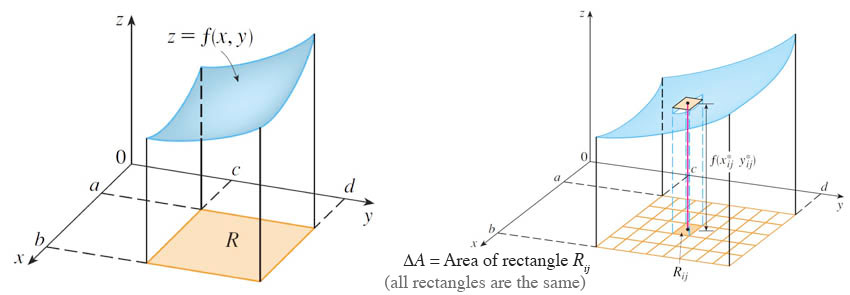Double Integrals
Approximating volumes with stacks of blocks...
Finding volumes using double integrals
Consider the volume, $V$, of the solid which is...


- bounded below by the rectangle, $R=[a,b]\times[c,d]$,
- Goes straight up from $R$,
- Is bounded above by the surface, $f(x,y)$.
- Split up $[a,b]$ into $m$ sub-intervals, split up $[c,d]$ into $n$ sub-intervals.
Approximate volume is $$V\approx\sum_{i=1}^m\sum_{j=1}^n f(x_{ij}^*,y_{ij}^*)\Delta A.$$ where...$\Delta A$ is the area of a rectangle with sides $\Delta x=(b-a)/m$ and $\Delta y=(d-c)/n$.
In the limit $\Delta A \to dA \to 0$ this sum becomes exact: $$V=\iint_R f(x,y)dA.$$
To do
- Double Integrals from Data
- Back to the Park: The average height is formally: $$\langle h\rangle = \frac{\iint_A h(x,y)\,dA}{\iint_A dA}=\frac{\iint_A h(x,y)\,dA}{A}$$
Iterated Integrals (partial integration)
How to evaluate a double integral like $$\iint_A f(x,y)\,dA?$$
We define partial integration of a function $f(x,y)$ with respect to $y$ with this notation: $$\int_{y=c}^d f(x,y)\,dy=A(x).$$ A(x) is the result of
- Treating $x$ as a constant,
- carrying out the integration with respect to $y$.
We write it as $A(x)$ because it is the area resulting from the partial integration w.r.t. $y$
The double integral is the result, next, of carrying out the integration of $A(x)$ with respect to $x$: $$\begineq \iint f(x,y) dA&=&\int_{x=a}^b A(x)\,dx\\ &=&\int_{x=a}^b \left(\int_{y=c}^d f(x,y)\,dy \right)\,dx\\ &=&\int_{x=a}^b \int_{y=c}^d f(x,y)\,dy \,dx\\ \endeq $$
This rather sloppy way of writing the double integral leaves it unclear whether you should evaluate the partial integral of $y$ first, and then integrate over $x$, or vice versa. Perhaps it doesn't matter?
Fubini's Theorem
...says that for a rectangular area $A$ and some pretty general assumptions, the order of partial integration does not matter.
Example 1
Find the volume underneath $f(x,y)=2-x-y$ and above the rectangle defined by points in the $x$-$y$-plane: $0\lt x \lt 1$, and $0\lt y\lt 1$. (Alternately, $R=[0,1]\times[0,1]$.)

$$ \begineq V= \iint (2-x-y)\,dA &=& \int_{x=0}^1\int_{y=0}^1(2-x-y) dy dx
\\&=& \int_{x=0}^1\left(\int_{y=0}^1 (2-x-y)\,dy\right) dx
\endeq$$
The $y$-integration happens for a particular $x$ value, so, we treat $x$ as constant... $$\begineq \left(...\right)&=&\int_{y=0}^1 (2-x-y)\,dy\\ &=&\int_{y=0}^1 (2-x)\,dy -\int_{y=0}^1 y\,dy=(2-x) \int_{y=0}^1 dy - \left. \frac{y^2}{2}\right|_0^1\\ &=&2-x-\frac 12 = \frac 32 -x. \endeq $$
Substituting this back into the expression for $V$, $$ V=\int_{x=0}^1(\frac 32 - x)\,dx = \frac 32 - \frac 12=1. $$
Example
 Estimate the volume under this surface, then integrate. The function is
$f(x,y)=4-x-y$.
Estimate the volume under this surface, then integrate. The function is
$f(x,y)=4-x-y$.
To Do
- Double Integrals Practice: #1-4
Double integrals of general areas
Our problem is now how to carry out a double integral over some non-rectangular region: $\iint_A f(x,y)\,dA=?$
$\iint_A f(x,y)\,dA=?$
We already now how to integrate just $dA$ over some arbitrary area. We can think of this as the volume integral of $f(x,y)=1$ over $A$, and so the volume=$1*A=A$. We'll use the same idea to integrate $f(x,y)$ over some arbitrary area $A$.
We shall find that the order of integration matters when writing down the limits of a double integral over an arbitrary area. However, the order of integration does not affect the final answer we get.
Order matters.
 $\iint_A f(x,y)\,dA$
$\iint_A f(x,y)\,dA$
- Integrate first with respect to y, ($\Rightarrow x$-dependent height)
- Integrate second with respect to x
Written... $$\int_{x=0}^1\int_{y=1-x}^{\sqrt{1-x^2}} f(x,y)\,dy\,dx$$
Order matters..
 $\iint_A f(x,y)\,dA$
$\iint_A f(x,y)\,dA$
- Integrate first with respect to x, ($\Rightarrow y$-dependent width)
- Integrate second with respect to y
Written... $$\int_{y=0}^1\int_{x=1-y}^{\sqrt{1-y^2}} f(x,y)\,dx\,dy$$
Example
 $\iint_A (4x+2)\,dA$
$\iint_A (4x+2)\,dA$
Regions
You should be able to sketch the region of integration in $x$ and $y$ given a double integral. For example: $$\int_0^1\int_y^\sqrt{y} x^2y^2\,dx\,dy$$
...means $$\int_{y=0}^1\left(\int_{x=y}^\sqrt{y} x^2y^2\,dx\right)\,dy$$
$\Rightarrow$

Changing the order of integration
$$\int_{x=-1}^0\int_{y=0}^{x+1}e^{x+y}dy\,dx+\int_{x=0}^1\int_{y=0}^{1-x} e^{x+y}dy\,dx$$
$\Rightarrow$

We could get the same result in one integral, integrating first over $x$ then $y$ like this...

The line $y=x+1$ can be re-arranged to $x=y-1$.
The line $y=1-x$ can be re-arranged to $x=1-y$:
$$\int_{y=0}^1\int_{x=y-1}^{1-y} e^{x+y}dx\,dy$$
To do
- Double Integrals Practice: #5-7
- Limits on Double Integrals
- Double Integrals: Problems